Guidelines for the determination of clay tobacco pipe finds
Author:
Don Duco
Original Title:
Richtlijnen voor het verwerken van pijpvondsten
Publication Year:
2003
Publisher:
Pijpenkabinet Foundation
Description:
In this article, the author outlines the method of cleaning and identifying pipe finds and drawing up a report.
Although the Malta Convention has not yet been ratified in Dutch legislation, it already brings changes in archaeological practice. By working in the spirit of Malta much more attention is paid to archaeology, both in the number of excavations and in the material research. This is also broadening the interest so that not only stone age and Roman eras are studies, but increasingly the more recent periods get attention. A favourable development for the research into clay pipes that it is taken more and more serious as an archaeological find and a source of further knowledge. Moreover, the obligation to publish the finds offers an enormous stimulus for making excavation reports, something which in the past was often omitted due to lack of attention, time and money.
The clay pipe is most useful for the interpretation of a find complex, for various reasons. Firstly, the tobacco pipe is the most common archaeological find from the post-medieval period with a clear fashion-sensitive nature, so that it can be dated reasonably sharp. Because of the fragility, there is a relatively high turnover rate which creates an extra sharp dating, although the lifespan of the clay pipe remains unclear and can vary greatly. Furthermore, there is both a main centre and regional production that make it possible to unravel trade patterns. Finally, the use of the clay pipe is status-related and often even personal.
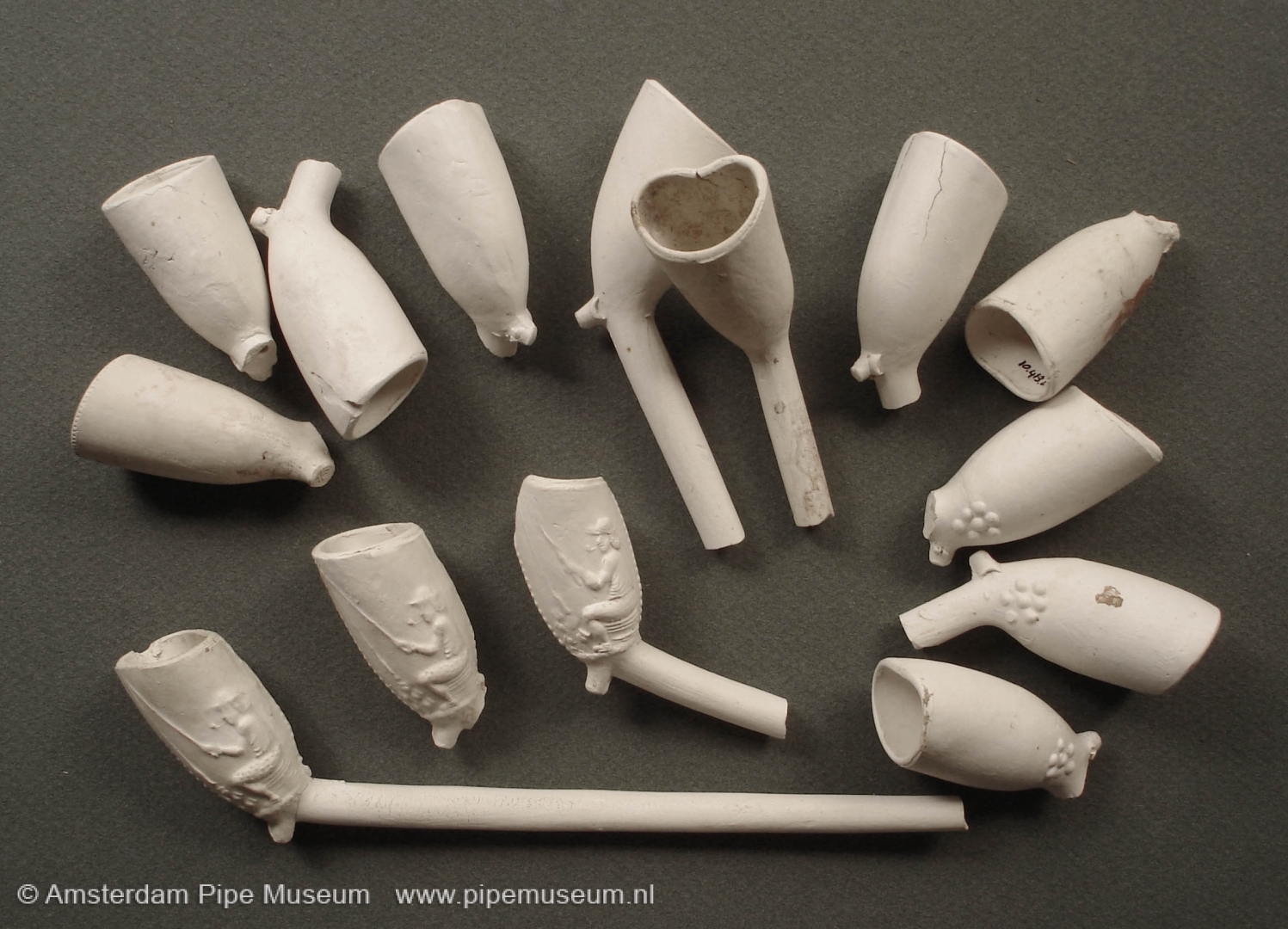
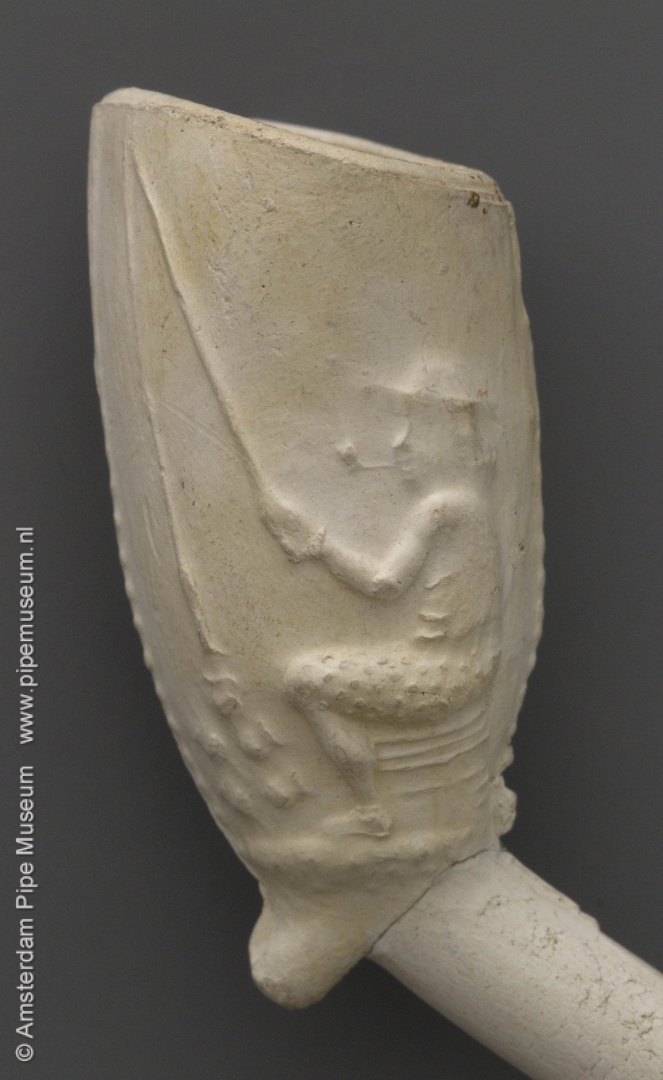
The clay pipe thus offers countless possibilities for archaeological material analysis and find interpretation. This has been proven in recent excavation reports. This series started with simple find reports about makers and their assortment, predominantly from the production sphere (note 1, Fig 1). Later, this research was broadened to user groups such as Bourtange (note 2) and at the moment an in-depth study on Alkmaar is being prepared (note 3, Fig. 2). This series of reports invites to making a synthesed research of the find complexes to get a better informed picture of the production, distribution and use of the clay pipe. A necessity for this is systematic and uniformity in the method of find processing and standardization of the find reports. This article presents some guidelines and recommendations for a uniformed method for processing pipe finds. When every researcher uses an unambiguous standard and uses the same disciplines, it is possible to compare the conclusions at a later stage better and above all more objectively.
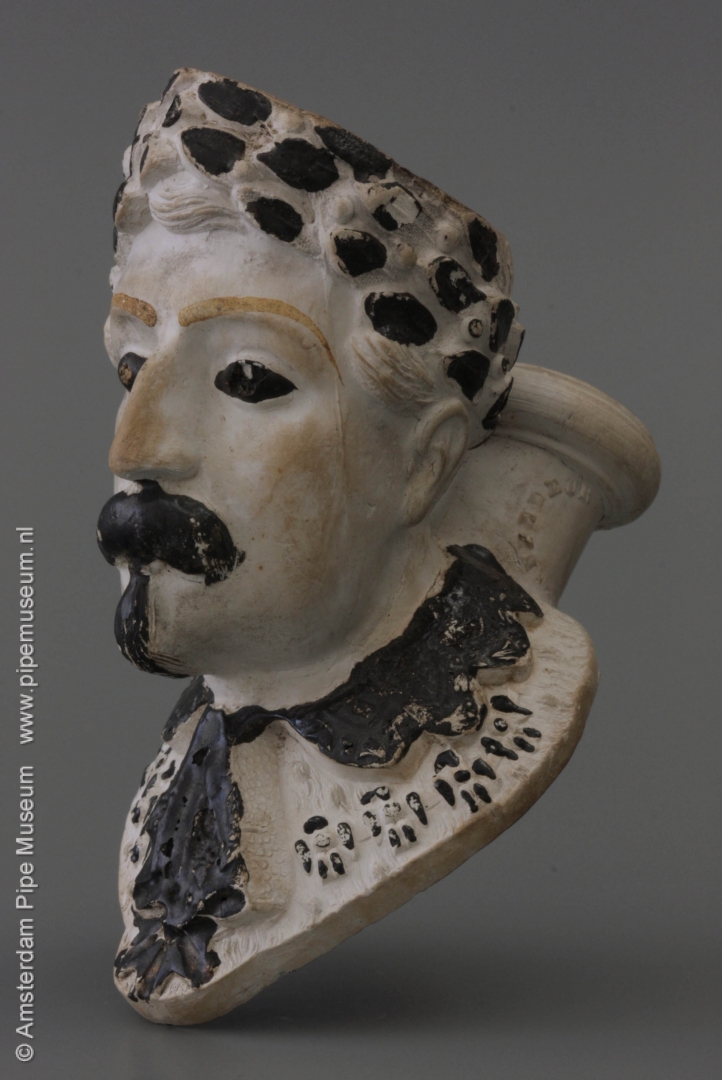
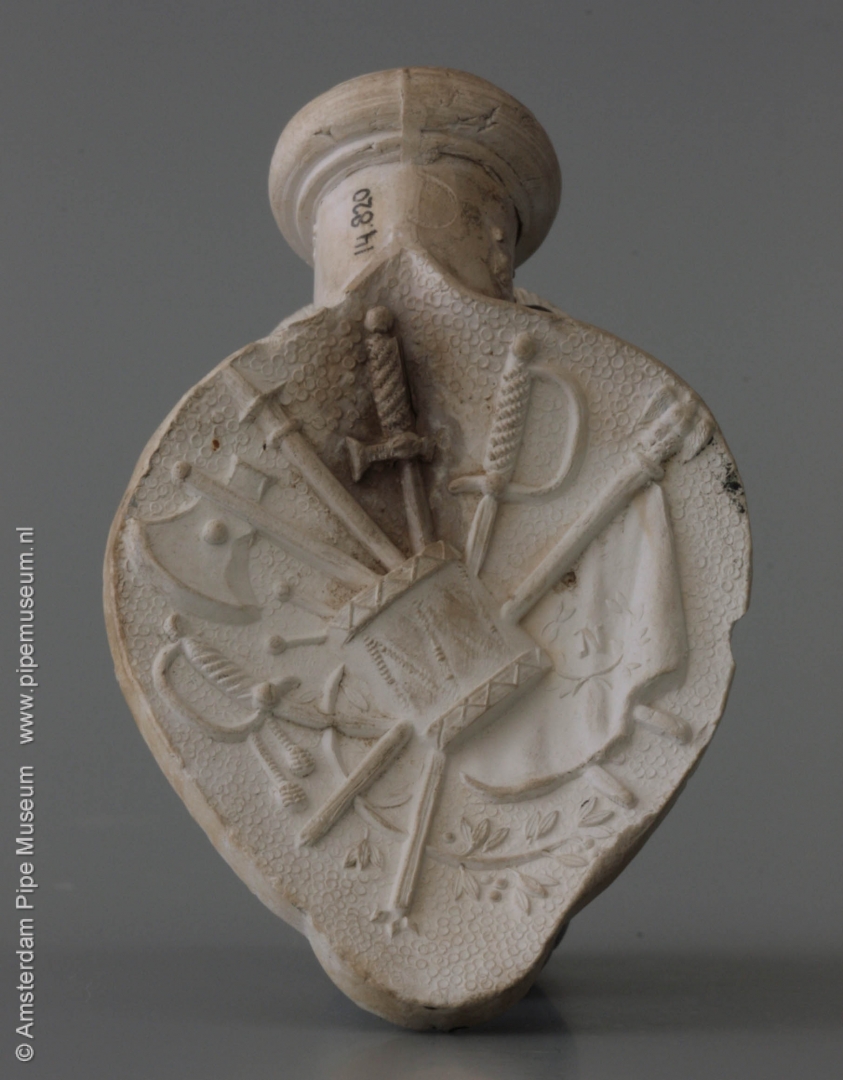
Subsequently, four steps are discussed in this article, in which the approach can best be done. The first step is the practical find processing. This is followed by three theoretical steps, that is filling in the determination tables, making the statistical overviews and drawing up a report in which the accounts of the excavation takes shape including the conclusions. After that, some bottlenecks and alternative possibilities for find interpretation will be discussed. The end of this article deals with the macro-analysis, the synthesis of sub-reports that should give an idea of the distribution and use of the clay pipe in the Netherlands, without time limits.
Practical find processing
The first, practical step of the find unearthing is the washing, drying and sorting out of the finds so that they are ready for further consideration and analysis. Cleaning clay pipes can be done with lukewarm water and a sturdy brush. It is advisable to brush away as much as possible soil and other contamination, so that after drying the objects are objectively comparable in terms of shade and colour. Drying can be done in the air, some archaeological services use a drying box.
After cleaning and drying, the fragments are exposed on a spacious table. When ordering, it makes sense to sort the bowls and the stems in such a way that a clear overview of the find is shown. It is wise to place the bowls on the left in a vertical row with the stems to the right. At the top the fine and porceleyne quality pipes are placed, the coarse material comes more at the bottom. By sorting the stem fragments behind the bowls at diameter, we gain insight into possible stem lengths as well as the percentage ratio of the finds.
When the pipes have been sorted out clearly, it is time to see if fragments fit. This often seems impossible, but the opposite is the case. Anyone who carefully sorts out the pieces has already more or less pre-sorted the number of hits. Moreover, all kinds of tricks can be used when fitting. The relationship between the stem thickness and the diameter of the stem bore indicates where the relevant piece of pipe stems were situated approximately. At the bowl end the stem is the thickest, while the diameter of the stem bore is the smallest. At the end of the stem, at the mouthpiece, the stem is the thinnest, while the stem bore is just the widest by the full length of the iron wire that has passed through both in and out which widens up the clay. In addition to the stem thickness, the placement of the stem bore, which is often slightly a-centric, is a good guide to fitting. Furthermore, polishing lines or unevenness’s of the surface result in the chance of finding pieces that fit. Centre of gravity stamps are usually located at a fixed distance from the bowl.
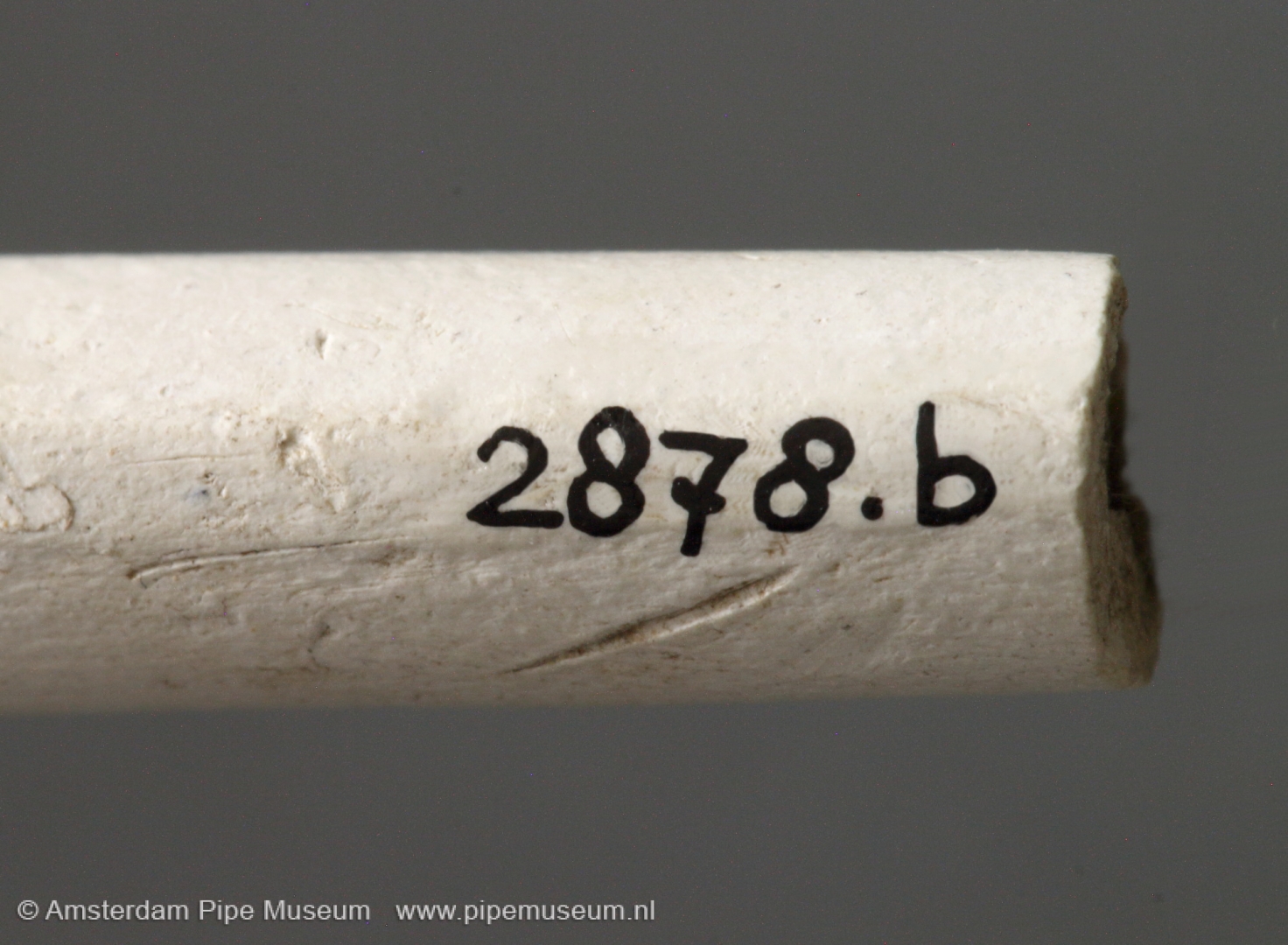
It is advisable to glue fitting pieces directly and not tape them temporarily. Each type of tape influences the surface of the porous pipe clay and later irrevocably will leave traces of discoloration which are extremely difficult to remove. When gluing, a colourless and reversible adhesive is recommended. The glued parts can best be dried in a sandbox in perfectly vertical position.
After appropriate parts have been glued, we proceed to the allocation of a final find number, this to prevent fragments having different numbers (Fig. 3). This means that the practical work is ready and the theoretical find processing can begin. This starts with step two: the determination of the material.
Determination tables
Before starting to identify, it is advisable to carefully examine the pipe finds again to get a general impression of the material. Such an inspection round should provide a basic idea of the finds. A first impression of the characteristics as raw material, technique, method of manufacture, decorations, marks and method of use is thus obtained.
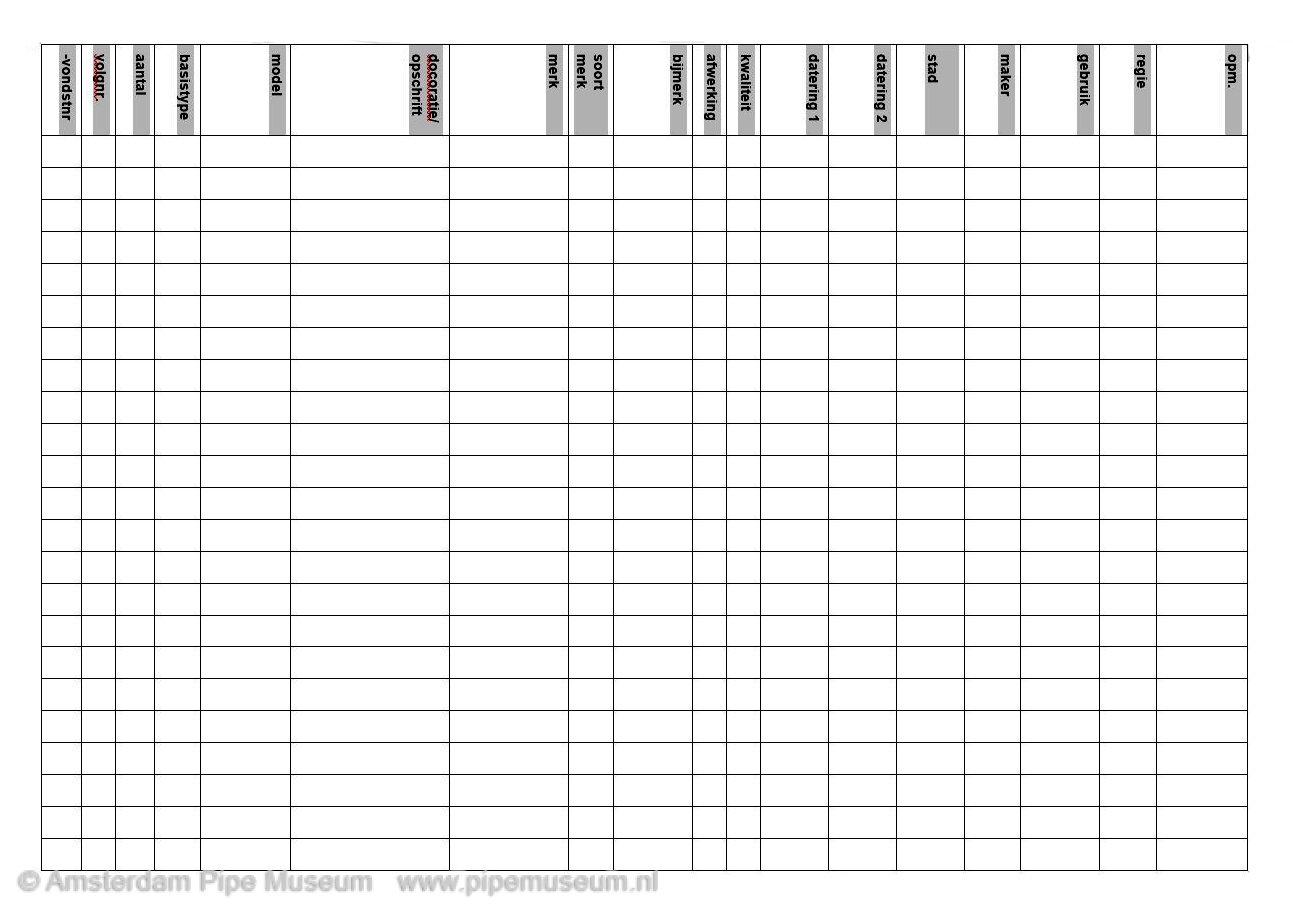
After this exploratory phase of looking and comparing, the external characteristics are recorded one by one using lists or a computer card (Fig. 4). The data card contains the fourteen fields that are discussed here. Depending on the question, this list can be supplemented or limited. The description card that is arranged in this way is useful both for archaeological processing and for museum data storage.
1. Find number
The unique number of the item eventually including the code of the excavation and its exact find spot, all according to find bag or label.
2. Type of object
Divided into function (tobacco pipe, cigar holder etc.) and condition (complete pipe, fragment, bowl, bowl fragment or stem fragment).
3. Material
For the clay tobacco pipe this is standard pipe clay. Other types of pipes to be found are plaster moulded, ceramic, porcelain or stone ware, on top of this alternative materials such as wood, meerschaum or in rare cases other materials.
4. Shape
Use the number of basic shape styles, as described in the Handbook.
a. Added description to refine the shape style.
b. Description.
5. Decoration
In logical order: bowl, stem, mouthpiece; added technical specifications such as moulded, stamped, painted, etc. Descriptions follow the focus of the smoker, meaning that left side of the bowl is the left side seen from the stem end.
6. Makers mark
a. mark + location
b. additional mark + location
c. mould mark + location
d. shape number + location (moulded/stamped)
7. Quality and finish
Apart from the main categories – ordinary, fine and porcelain – it can be useful to add in-between categories like ordinary/fine and fine/porcelain, especially in cases where it is not certain to which category a pipe belongs. Treatment of the rim of the bowl (cut of, rounded, trimmed). If applicable mention specific features in finish.
8. Measures
Height x width (thickness) of the bowl followed by the length of the stem, measured from its origin at the base of the bowl.
9. Origin
From large to small: country, region, town, maker (if possible with period of activity of the maker).
10. Date
Dating, using period date in years from the oldest to the youngest possible date.
a. date known for type/shape/style
b. production period of the maker, eventually his heirs using the same marks
c. production time of this specific find, retrieved from usage of the mould or other characteristics
11. Micro wear analysis
Gradually we distinguish four steps: unsmoked, sparsely smoked, mediocre to normal use, heavily smoked. Eventually other signs of use, such as wear and tear (use-wear), dental abrasion.
12. Remarks
Comments and additional information not to be placed in other sections (weight, contents of tobacco, specific characteristics of the press mould, baking defaults or other signs from the production, reuse etcetera).
13. Literature
References for determination, sources of specific information on the finds.
14. Illustration
Drawing or photo number.
The aforementioned checklist has been drawn up using the deductive determination method (note 4) and encompasses the main factors that lead to the identification of clay pipes. The numbers 1 to 8 are predominantly descriptive in nature, it is more about recognizing externalities than about insight. With numbers 9 and 10 it one needs knowledge by experience, to be verified by professional literature.
At the end we see three additional fields (nos. 12-14) that are needed later in preparation of the find report. Until a few years ago the determination tables were filled in on paper, nowadays mostly on the computer. To stimulate efficient working, it is advisable to file the data in an Excel sheet on the computer. Of course, a selection list can be used for each field to ensure fast and error-free entry.
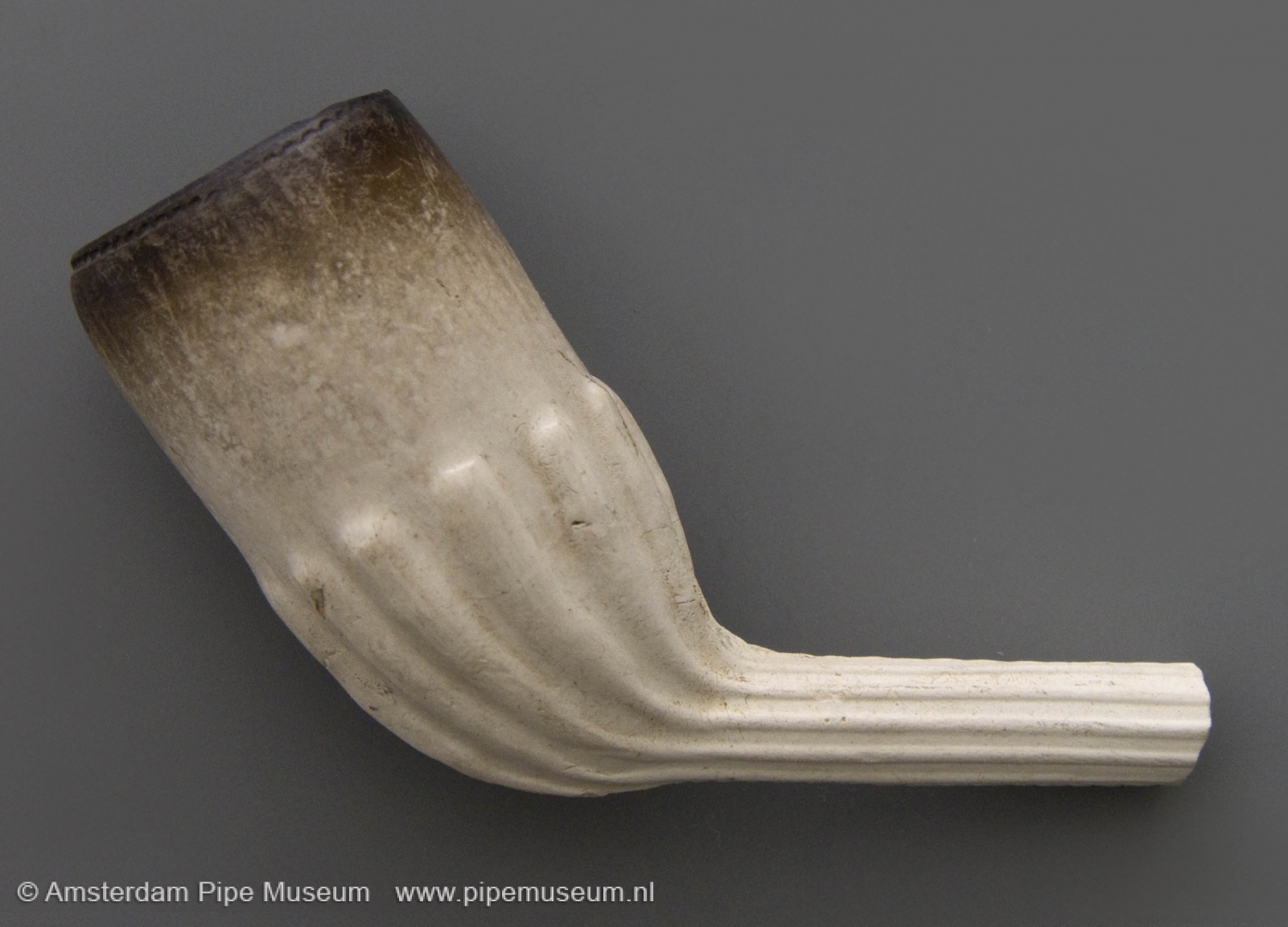
The most subjective assessment will be seen at number 11: the intensity of use or the carbon layer in the bowl of the pipe (Fig. 6). Two factors blur these observations. When the clay pipe is in use, the fire traces don’t grow evenly over time, in fact after an initial fire and carbon deposition the effect of the combusting tobacco gets less and less over time. Little more carbon deposition is therefore a much longer use. Gradually, the deposition of carbon in the bowl will form a hard, impermeable layer. Often this residue will partly dissolve in the earth and is washed away, so that the intensity of use is no longer recognized correctly and will be judged less strongly. A second blurring factor is that the smoke traces as to be seen in the stem grow faint in the soil or even almost disappear. In short, it is often a subjective observation. It may be advisable to first have a general overview of the user characteristics and then enter the intensity of use of all objects in the computer in one go. In this way, there is at least a logical interdependence in the qualification, on other words a relative rating.
In addition to the intensity of use, we can keep an eye on the nature of the fire traces that sometimes indicate a fixed method of lighting or a specific smoking behaviour. Above a candle, for example, the outer edge of the pipe bowl will blacken. In a special case, one particular smoker can be distinguished in the find material, for example if this person has constantly lit the pipe from one side, so that a characteristic soot shows differently. Wear marks on the mouthpiece of pipes say something about specific or intensive use, while chips missing along the rim of the bowl indicate a certain way of emptying or tapping the pipe bowl.
A fixed modus of formulating is used for the literature and notes consulted. There are generally accepted scientific rules for this. These are not laid down in national guidelines so that the archaeological institutions and companies often use their own system, which is not helpful in the long run. Consequence in citing is the most important.
Finally, for those who want to make a complete description of a clay pipe in a running text, the following order can be of use. First state the function and continue with the bowl shape, the marking, the stem and the mouthpiece. Then follows the decoration of the bowl and the stem. Then it is time for added features such as the mark or special finishing. Finally, it is advisable to mention the traces of use. As you will notice, this sequence is not coincidentally the same as with the deductive determination method (Fig. 7). The captions of the images are ideally structured in the same way, so that the way of looking, assessing and describing always takes place from the same system.
Summary statements
After the tables with determinations have been filled in, they can be worked out into overview statements. In this way we get a better insight into the numbers of pipes found, the periodization of the finds, including the variation in occurrence and use per period. The first act is counting the finds, where we make a subdivision into bowls, stems and mouthpieces. We count every bowl or base of it, with or without heel or spur (note 5). The total number of fragments found says something about the size of the find material.
For the fragments found, the number of bowls and bowls fragments usually indicates the minimum number of copies thrown away. In exceptional cases, there may be more mouthpieces than bowls and that would be evidence of the number of pipes used. The minimum number of pipes found is indicated in MAE (minimal number of copies) in archaeology (note 6). The MAE of a find complex provides information on the consumption of a certain article. If this figure is divided by the period that the find complex spans, this quotient indicates the consumption per year. The MAE has been devised for all kinds of finds and has become common practice in the processing of ceramics. In clay pipes, the MAE often provides significantly more insights because the dating of pipes can usually be given fairly accurately. For pipes a MAE-quotient per decade is therefore strongly preferable over a calculated average consumption over the entire find period.
The lower the MAE quotient, the smaller the circulation of a specific item has been. When interpreting the quotient, the clay pipe can be compared with other ceramics and additional finds. Over time the consumption quotient of the clay pipe increases. This has to do with the general growth in material terms, a pattern that we see in all material groups from the late Middle Ages on. In addition, the habit of smoking since the introduction increases strongly and eventually spreads across all layers of the population. The clay pipe therefore occurs from the year 1600 onwards with increasing numbers, although there are variations caused by economic fluctuations and changing user patterns. Of course this is also closely related to the smoking behaviour that is different in every social class. The tobacco pipe thus offers the opportunity to unravel and define economic factors in addition to the taste and popularity of smoking.
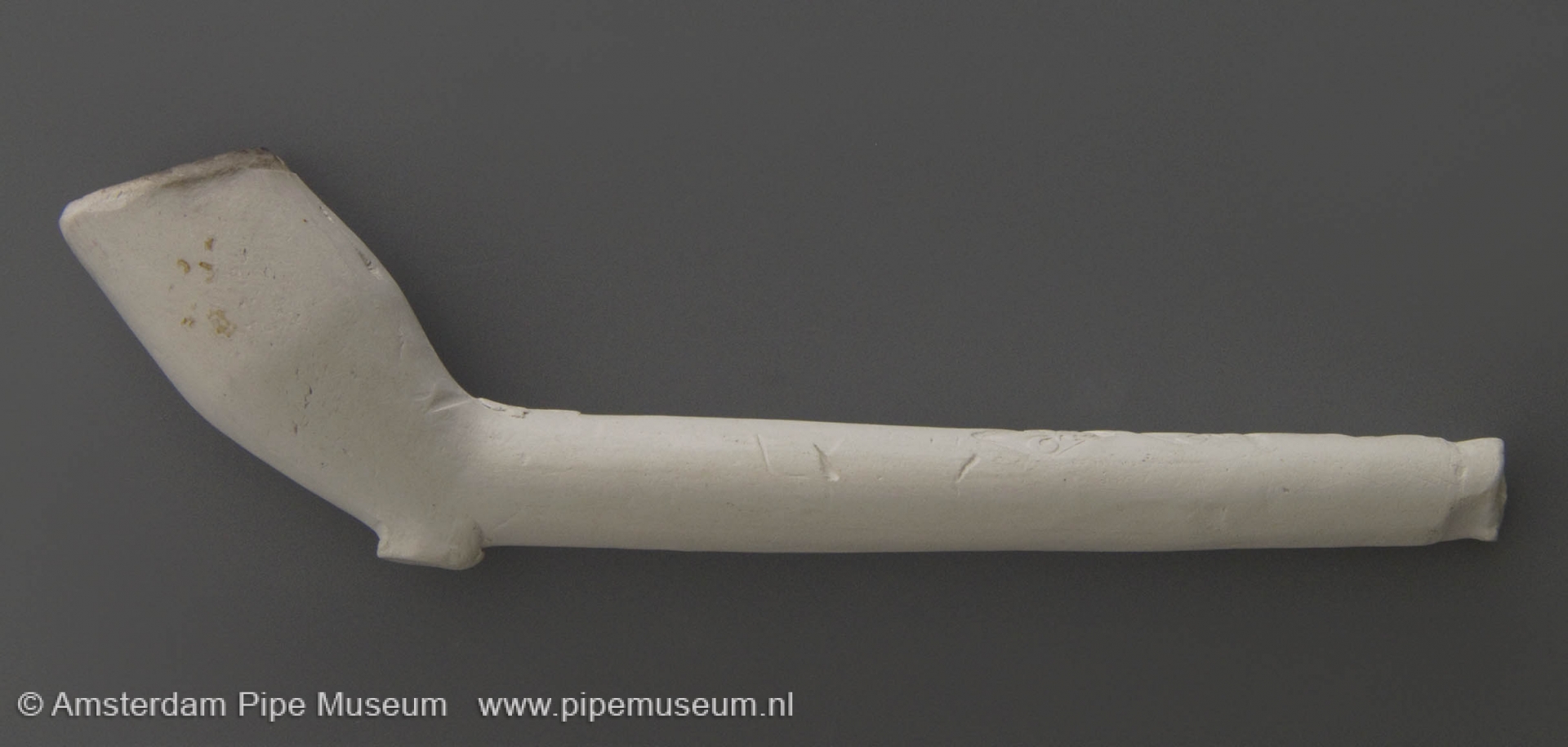
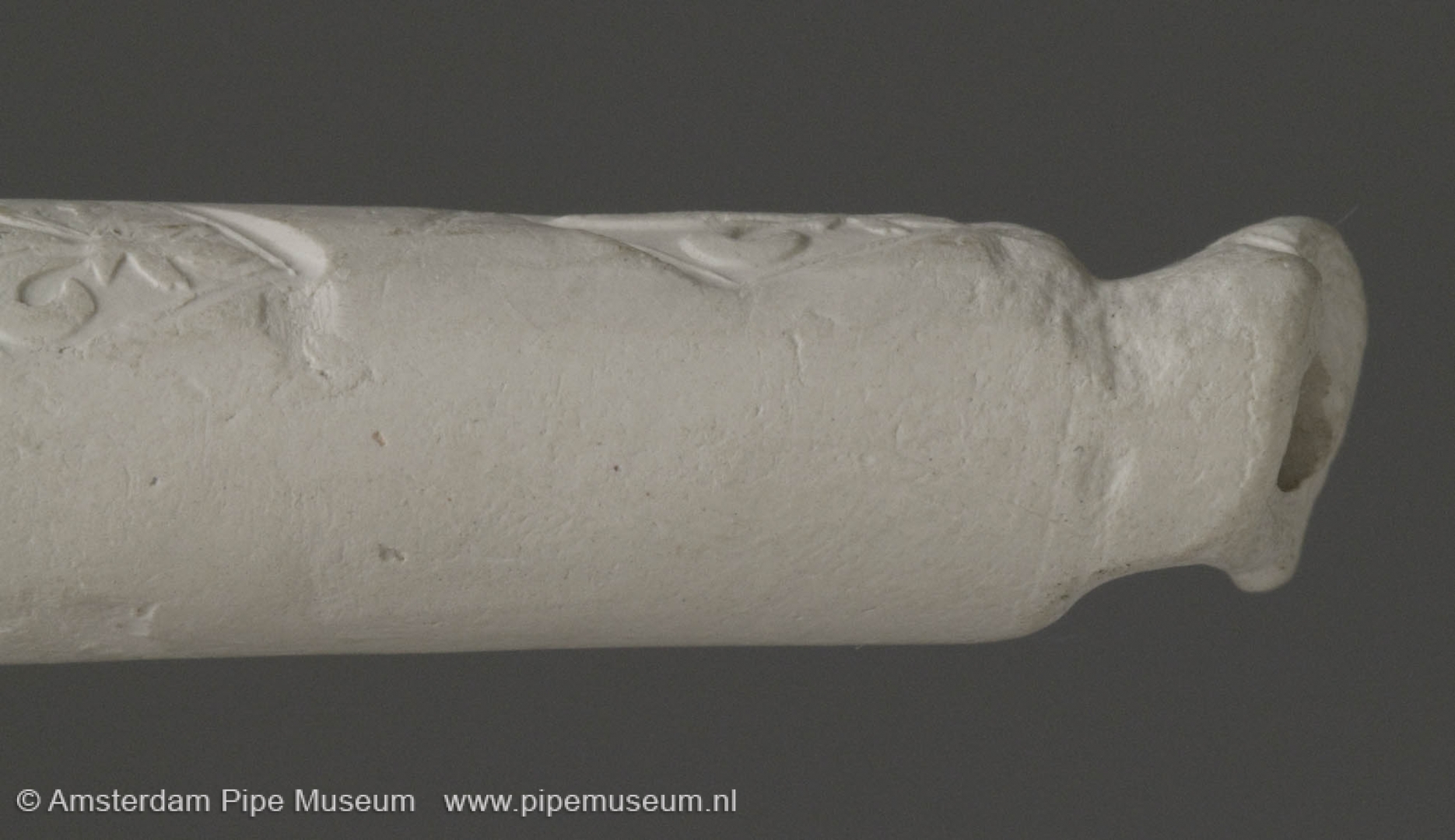
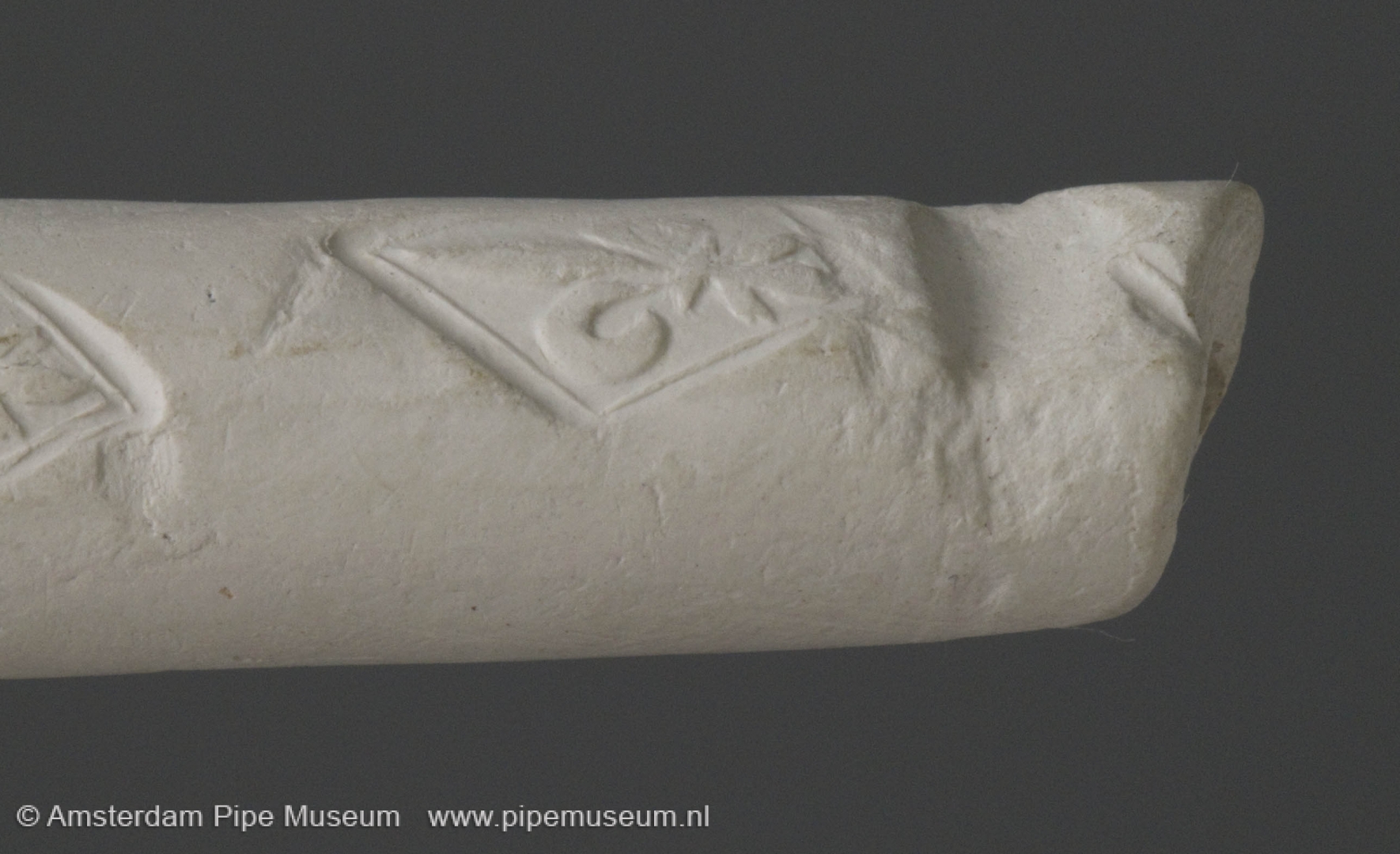
In a rich social setting, we generally find a high percentage of expensive goods, for poor people the material is predominantly inexpensive. Moreover, the life span of an object is usually longer in the lower shifts, resulting in more traces of combustion or wear and tear of the pipes. We speak of material prosperity when a find complex yields a relatively large number of pipes in the more luxurious quality and, moreover, testify to more restricted use per item. In the case of poverty, this is the other way around (Fig. 8). In addition to the factor of prosperity or poverty, clay pipes can display specific characteristics that have to do with the taste that the smoker shows through his personal choice of pipe and his desire for show and parade. These personal characteristics that the find material emanates are the most difficult to specify.
In addition to the total volume, it is important to have an insight into the percentage that was recovered, of course only possible when all stem fragments were collected by means of sieving, something that is rarely done in practice. This can happen in different ways. If we add the length of all pipe stems and divide this by the MAE, then that result will indicate the recovered length per pipe. When we compare this with the assumed length of the original pipes, we get an idea of what has been found. The weight of the find material can also indicate approximately how many percent of the pipes have been recovered. However, this is more complicated because the weight differs per type of pipe and varies over time. This calculation only applies when we elaborate this with great care. By dividing the weight by the total number of fragments found, we arrive at the fragmentation factor, the degree of breakage in a particular find complex. The calculations and estimates mentioned in this paragraph are only of any interest if a comparison with (various) other find complexes is possible. For only one single find spot it has no use, since it gives just a number. In comparison these figures get a meaning as an indicator of the specific user conditions or waste processing at the time.
Other data that can be expressed as a percentage are the distribution of the material over time, the shape variation, the distribution of marks, the quality, the origin according to region or location and the intensity of use. By making constantly similar states of this, the starting point of the reporting is always the same, so that it is possible to compare this data later with other reports. A warning is appropriate here. When the total number is too small for each category, statistical calculation offers little useful or even highly biased information.
An important insight provides the geographical distribution of the clay pipe. The origin expressed as a percentage of the production location can easily be calculated and displayed in a model. It is also worth remembering that the distribution of pipes in the past was mainly along established trade routes since many manufacturers maintained regular contacts with wholesalers who in turn operated through fixed distribution points. Unfortunately, those patterns of yesteryear are difficult to fathom and they are thwarted by sales of fair sellers, peddlers and other people who provide a supplement to the usual market supply. Although this might be a supply with a certain regularity, it is nevertheless a less structured offering that is bound to changes more strongly. Of course, the fashion factor traverses the habit patterns.
Moreover, if the find complex contains larger numbers of pipes from a regular trade channel, it is possible to find out more about the size and frequency of the deliveries by studying the shape of the pipe using the pipe findings. The appearance of mould marks from the same workshop gives us the possibility to determine the number of used press moulds and thus determine the size of the company at that time in relation to the deliveries to that location. In an ideal case, the different deliveries can be determined based on mould wear and follow-up by new press moulds and can be plotted over time. This method has already led to well-founded period dating (note 7).
Special find groups are provided by shipwrecks. These yield a micro household of the skipper with often modest, sometimes even meagre possessions. Besides the personal items we also find the gear of the sailors and belongings of the passengers. The ship's inventory is particularly interesting because it is not related to a pattern in waste processing as is the case with other archaeological sites, but to the used household goods taken from home and still present at the time the ship went under. In addition, there is the cargo of the ship intended to be delivered with a nature and quantity that is completely independent form the belongings of the sailors. This cargo is always individual to each sailing trip, but may fit in a standard pattern of recurring deliveries.
Evidently, the expertise of the editor of these summary files and his manner of working determines the reliability of the overview statements. If the find processor has more experience and possesses thorough knowledge and also follows a meticulous approach, then the results are optimal. If there is less knowledge or sloppier work, then the (quality and usefulness) adequacy of the work drops quickly. After counting, calculating and processing the information in clear overviews, it has become time to record the findings in the excavation report. The next section is devoted to this final step.
Reporting and conclusions
After step two, describing the finds and step three counting and calculating percentages, comes the fourth and most difficult but also the most challenging step: analyzing, interpreting and concluding. This is done in a running text or essay that is even more than step three depending on the insight and experience of the author. The excavation report is divided into an introduction that explains the working method and presents the find complex. The main text provides an image of the findings based on the overview statements and discusses the special finds of the excavation. Finally, the conclusion follows with a final word.
The introduction is to justify the report. First, the excavation is explained, both geographically and in terms of content. For this purpose, reference can be made, if applicable, to the general goal of the excavation of which the pipe finds are part. This includes the nature of the excavation: does it concern an archaeological survey, a trial trench or a full and systematic excavation? In anticipation of the find interpretation, it is important to state what has been found and according to which method. For example, in the accuracy of calculations it makes a lot of difference whether the material has been sieved so that all the fragments have been recovered or the digging was done by shovel only, so that the most fragmentary part has irrevocably ended up on the dump.
Of great importance are the find circumstances. Is it about untouched layers or disturbed and contaminated excavation layers, scattered finds or a find complex with a demonstrable undeniable connection. Furthermore, it counts whether the find is representative of what has been discarded or that it is only a part. The carefulness of digging up greatly affects the reliability of the reporting. In summary, the introductory text gives the reader a general picture of the complex so that it becomes clear how the excavation was carried out, what scope of the find material is within the whole excavation and what the limitations are. The introduction of the find report ideally ends with a specific research question.
The excavation report certainly should not include a general overview of smoking or the development of the clay pipe. This history belongs in a handbook or in monographs where the culture of smoking is central. The general introductions about the history of smoking and the pipe preceding a find report not only constitute a disturbing repetition of general knowledge, but are often even below par. In most cases it occurs, it is to disguise a lack of substantive information on the dig itself. It is the art to focus the report entirely on the find group concerned and to include the relevant piece of pipe history succinctly in the main text in a charming and therefore inconspicuous way, with reference to relevant manuals.
The main text presents the findings to the reader and lists everything that is important about this material. The information collected in the overview statements made according to period, origin, occurrence and use can be presented in the form of tables or diagrams. In addition to such a matter of fact part on numerical basis and provided with percentages, a running text must be included that describes the special objects from the find group. By differentiating the remarkable finds from the regular goods, users from this particular group of objects will set themselves apart from other smokers. Of course, the size of the main text is closely related to whether enough a-typical material is found or whether it concerns purely regular goods. Moreover, some products can be interpreted extensively while other pipes do not offer this possibility.
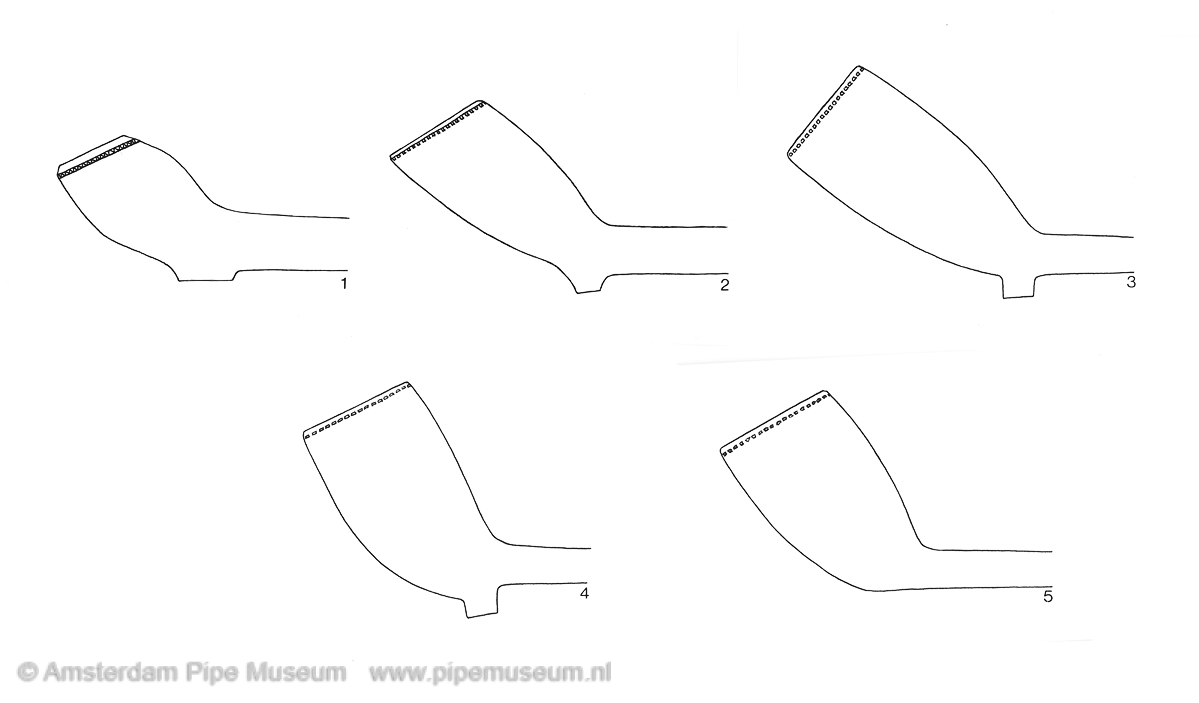
In case of a find group that runs over a long time, it is preferable to divide the finds per period. Ideally, this periodization is made up according to the occupancy history of the location. However, if the history of the site cannot be determined, the other option is to divide the group according to the development of the pipe shape. Then the division follows the five periods defined by the consistency in the outward form of the clay pipe. These are respectively the first generation up to 1620, the period of the bi-conical pipe shape of 1620-1680, the transition time from funnel shape to oval from 1680 to 1730, the time that the oval pipe bowl reigns from 1740 to 1850 and the last phase dominated by various pipe shapes from 1850 to about 1940. This last phase is also the time in which the clay pipe comes under the influence of pipes from other materials and alternative smoking methods. In order to create a visually clear overview, it is a good option to use a bar or pie chart.
In the description of the find group, reference to the additional finds can add an extra dimension. The status of the other find material and their place in the socio-economic structure of the habitation history or user history of the site often provides important additional information to understand the consumer. It positions the social and personal circumstances in which the tobacco pipe is smoked and makes a comparison possible of the choice of the pipe against other taste patterns such as tableware and decorative items in the same household. In addition, tobacco related objects can be of great importance to fill in the image of smoking. In a special case, for example in retrieving human remains, traces in the teeth tell more about the intensity of a smoking individual. Wear of the teeth isn’t only an indication of the duration of smoking but also of handling of the pipe. Traces of wear across the full width of the teeth or one or more wear holes say something about the smoker and the way he or she handles the clay pipe.
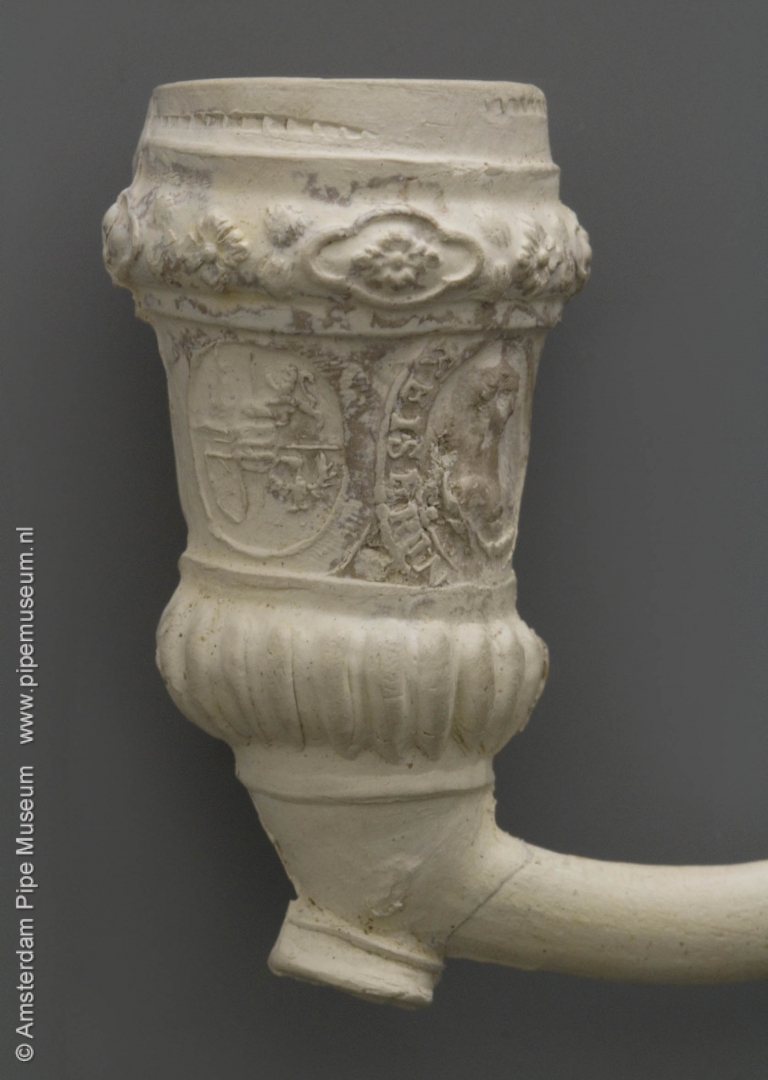
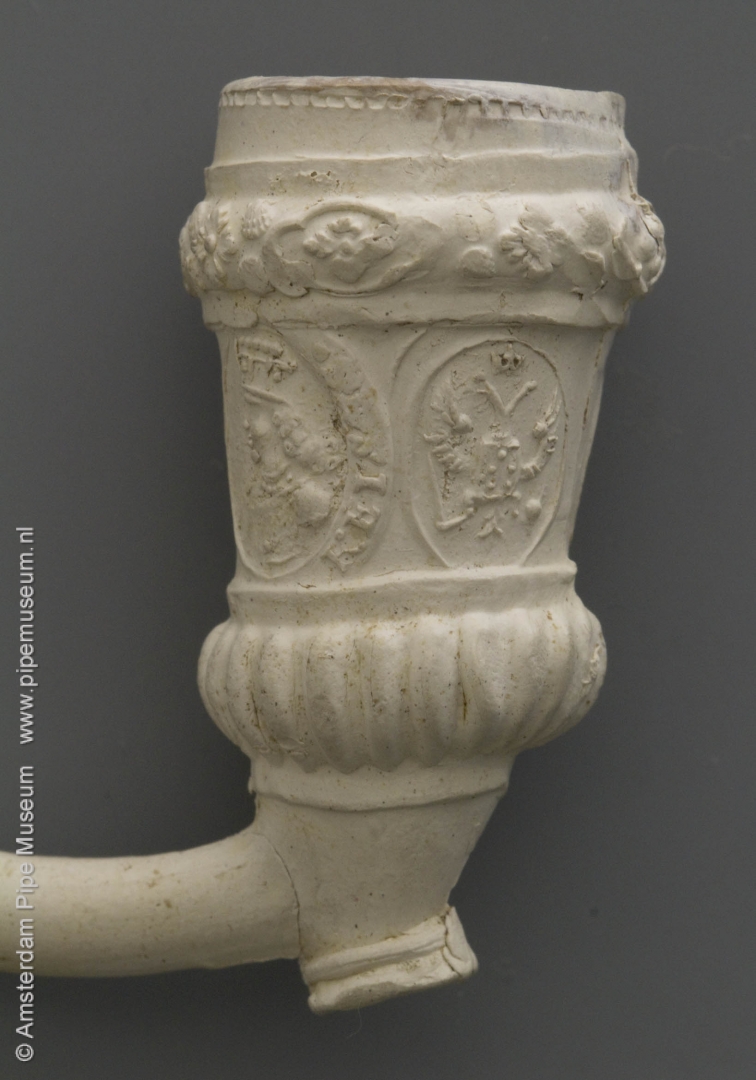
When the find report is placed in a general archaeological report, there is often discussion under which chapter the pipes should be arranged. In fact, pipe smoking belongs in the category clothing and personal outfit: tobacco is a stimulant that is often consumed as relaxation and pastime and at the same time a personal choice of luxury gadget. Some reports speak of a leisure category, in which the use of tobacco is treated together with the consumption of coffee, tea and alcohol. In both cases, the objects separate from the material group of ceramics and are therefore discussed in the light of their sphere of use. Strictly speaking, the clay pipe is part of the ceramic, although treatment in this category is not the most logical one. The ceramic objects in the household show a reflection of a shared spending and habit pattern of the entire family, while smoking is more a personal choice. In addition to the regular purchases, we may also find among the smoking articles, occasional items (Fig. 10) and a-typical objects, pipes that have been presented to the smoker as gift. These last two categories do not necessarily correspond with the personal taste of the user.
So far, the reporting is an interpretation of the finds based on a description of the external characteristics. This information will draw a picture of the utensils, their mutual connections and their original users. Ideally, this knowledge is tested and expanded with information from archive sources of any kind. The ultimate purpose of the conclusion is to set up an independent reasoning that links the findings of the research and places them within a broader framework. The whole complex of facts taken from the find material is the starting point to get to a higher level of knowledge: the interpretation. This could include trade relations and market supply, but also the personal taste of the smoker and his social status. That is the less concrete part of the find report, sometimes inevitably somewhat speculative but composed with care always realistic and above all fascinating.
In principle, the excavation report ends with the conclusions, which not only place the smoking devices in time and indicate the particularity, but ideally also provide an image of the users of these objects. It identifies the original owners as, for example, heavy smokers with humble smoking pipes or occasional users with a luxurious product. In ideal cases atypical patterns can also be recognized, such as a pipe with a political colour that does not fit the social class, as well as an expensive pipe that can be smoked by a low-ranking servant or vice versa. The conclusion substantiate the special patterns and set them in contrast with the regular smoking behaviour. A comparison with other find reports or information obtained through a literature study can sometimes be instructive. Here, too, the more experienced processor can come to a more complete and comprehensive picture, because he can make comparisons with other find complexes from a comparable or non-comparable context.
After the introduction with research questions and the main part of the report with all the findings - whether or not subdivided into paragraphs - the conclusion summarizes the work. However, there is still a possibility for further investigation in the future, the next section is devoted to this.
Thoughts and possibilities for further find interpretation
Archaeology mainly provides insight into the pattern of throwing away objects, so that the interpretation back to the original situation of the objects in use is often speculative. The way in which an archaeological context is formed thus determines to a large extent what is found; hence the importance of describing the type of excavation. We should not underestimate the factor of excavation undisturbed layers versus disruption, contamination and the phenomenon of secondary finds. This is the case with many archaeological projects and they sometimes seriously complicate the interpretation. The disposable pattern is at the base of every dump location and that can be very varied. It varies from the incidental loss of an object to the regular dumping of waste from a single person to larger numbers of users. The complex is dated according to the find material with the most recent object as closing date. Of course, objects with different dates can be thrown away at one time. An exception to this is the shipwreck that has already been mentioned in that context and provides insight into the pattern of use, namely that at the moment of the ship's sinking.
Interesting but complicated factors are fashion and taste that move in complicated wave. The appearance of the pipe changes under the influence of fashion but is also strongly influenced by the economy, so that the proportions in which the product is sold constantly change. More expensive pipes are popular for a certain period of time and by consequence more numerous in circulation, in other periods the interest in prestigious smoking equipment decreases and the average occurrence of the pipe drops. Preferences for long or short pipes, decorated or undecorated, also change over time. For example, the long pipe enjoys more interest between 1740 and 1750 than between 1780 and 1790. The decorated pipe was significantly more popular in the 1630s than in the 1650s or 1660s. We thus see complicated curves between fashionable and traditional, between quality and non-quality, between long and short, between decorated and smooth and all other variants that are possible. In order to be able to recognize these changes, it is necessary to first define what is expensive and scarce compared to ordinary and prevalent.
The user group can be divided into three social categories: the upper layer, the middle class and the lower layer. Every grouping can be categorized in itself again. At the upper level we speak of the elite including the nobility and directly beneath the rich magistrate. The middle classes include the wealthy and well-to-do bourgeoisie, merchants and, in some cases, established tradesmen. The lower layer of society is formed by shopkeepers and craftsmen, including the workers and servants, and finally the poorest. This rough classification applies more strongly to the cities than to the countryside. In addition, the distinction between the Dutch trading cities and places in the province must be taken into account. In that respect, every city or region shows its own patterns.
Establishing the social class on the basis of smoking equipment is not always possible and certainly speculative. Smoking is not just class-related, there is also personal preference. A wealthy smoker does not have to use expensive pipes, while a poor smoker can treat himself to a luxurious pipe. Furthermore, the curves are even more complicated because, as already noted, the economic relations vary per period, and moreover the trade relations are different from place to place. All this is under the influence of social unrest and wars, tolls and taxes and so on.
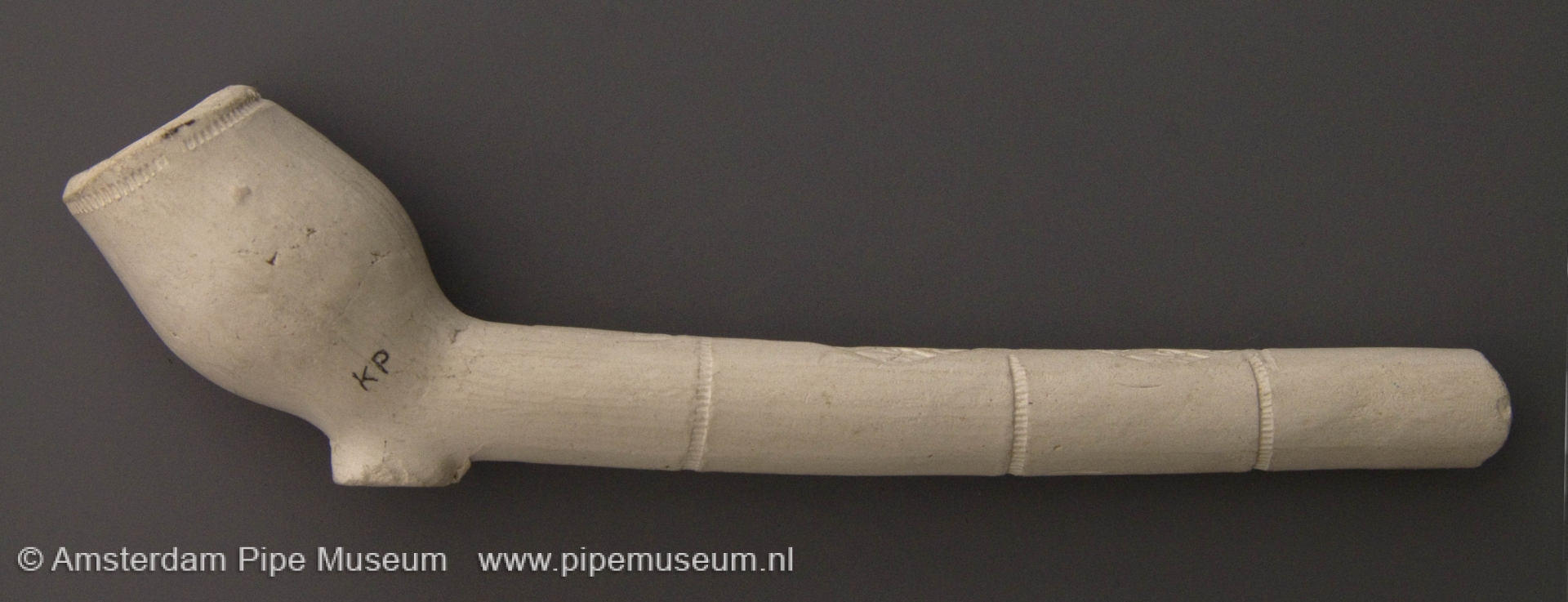
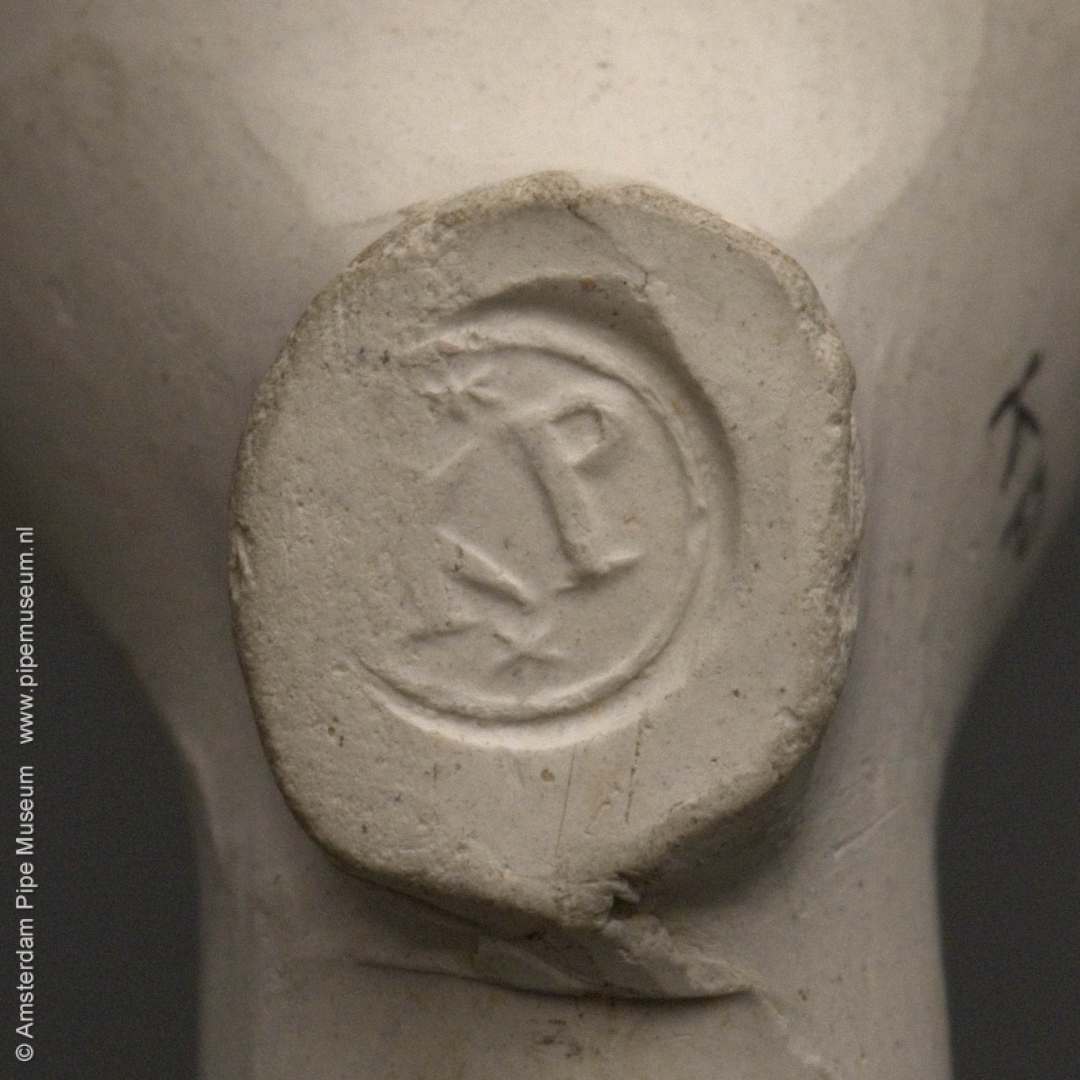
Having said all this, user complexes can provide valuable knowledge about consumer choice and consumption patterns in addition to business information and data on trade patterns. The fact that there are regional preferences among smokers is not new, but how they develop over time and which factors they are depending on, it is by no means always known, nor what factors underlie it. As an example, we know that in the northern parts of Holland and West Frisia the smoking equipment is more exceptionally designed than in places like Amsterdam and Haarlem. In the province of Zeeland, on the other hand, there is interest in tobacco pipes with larger bowls in the seventeenth century (Fig. 11). Such preferences can be explained from the fashion pattern and the taste perception of the smokers who may be determined by the tobacco varieties used and their method of preparation. Even the climate factor can play a role, sometimes in combination with a regional fad or a certain local sense for parade.
There are many incorrect ideas circulating about the use of the clay pipe in the past. A clay pipe is not a disposable article as is often mentioned, but at most a consumable item. The smoke traces in the pipe bowls sometimes indicate a useful life over a very long time, despite the fact that they are often difficult to read. Clay pipes can last for months or even years. In addition, we are completely in the dark about how many pipes an average smoker smoked per day. Presumably as relaxation and for stimulation little more than one. This assumption is speculative with as extremes, the continuous addiction to incidental smoking solely for distraction. When dating, we have to take into account the useful life estimate and, to be very meticulous, even the storage or warehouse period that precedes the period of use and which, as we know from archival sources can be considerable, should be part of the argument. Furthermore, it is useful to think about the reason for throwing away. This may be due to breakage during smoking or disposal due to clogging of the pipe stem. Many other reasons may be the basis of the disposal, such as moving places, changing the tow barge or cleaning up after the death of a smoker.
An alternative possibility for interpretation of finds is the analysis of the clay composition. Apart from a few rare exceptions, no research has yet been done in this field. Cutting sheets of pipe clay could help us to identify the objects more accurately and can be decisive for determination in case of doubt.
Finally, it should be noted that the clay pipe as an archaeological find is not always related to the smoker. Archaeological finds can also involve breaking material before consumption, for example from production waste or calamities during shipment or distribution. In addition, it may be pipes with an alternative function, such as decorative, shooting or bubble blowing pipes, while also reuse to whistle, bead or curler occurs. Only in those scarce cases we can speak of multi-functionality of the tobacco pipe.
The macro analysis
If multiple find groups are processed with the same criteria over a longer period according to the same system, the results provide a basis for comparison in a broader context. By plotting the results of the various researchers in time and space, the possibility arises to analyse the distribution pattern of the clay pipe over larger areas or perhaps even the entire country and to interpret the smoking habit over several centuries, including the social position of the clay pipe smoker and his specific preferences. Such an analysis leads us from a restricted time frame to a general understanding of the use at the macro level.
Unlike other types of ceramics, the clay pipe can be dated to a margin of ten to twenty years or even less. This makes it possible to give a comparison of production, trade and consumption patterns per decade. No material group other than coins that deliver a fixed terminus post quem can offer such an exact periodization and that makes the clay pipe unique as an indicator of multiple insight. The subdivision into qualities and established species leads us to information about the prevailing fashion, the status of the smoker and the quality pipe that he chose to smoke, naturally in the light of the market supply. The regional spread of the industry provides insight into the trade patterns underlying the distribution. With a sharp dating as a starting point, quantification means that we will soon have a clear vision of the mutual relationships and spread in space, always within timeframes of about ten years.
However ideal this might seem in theory, working out a macro analysis is frustrated by a number of factors. Firstly, that is still the limited number of find reports that have been developed in such a way that they offer at least a sharp periodization. The general problem of the small printing numbers of many archaeological reports and therefore difficult retrieval is another factor. It is also muddling that the find material always gives a reflection of the disposure pattern: the cohesion came about at the moment of throwing away, while contaminations in particular in the context of the city are the order of the day. Because each find group is always different from any other, the curves of time and space never run parallel in such a macro-analysis.

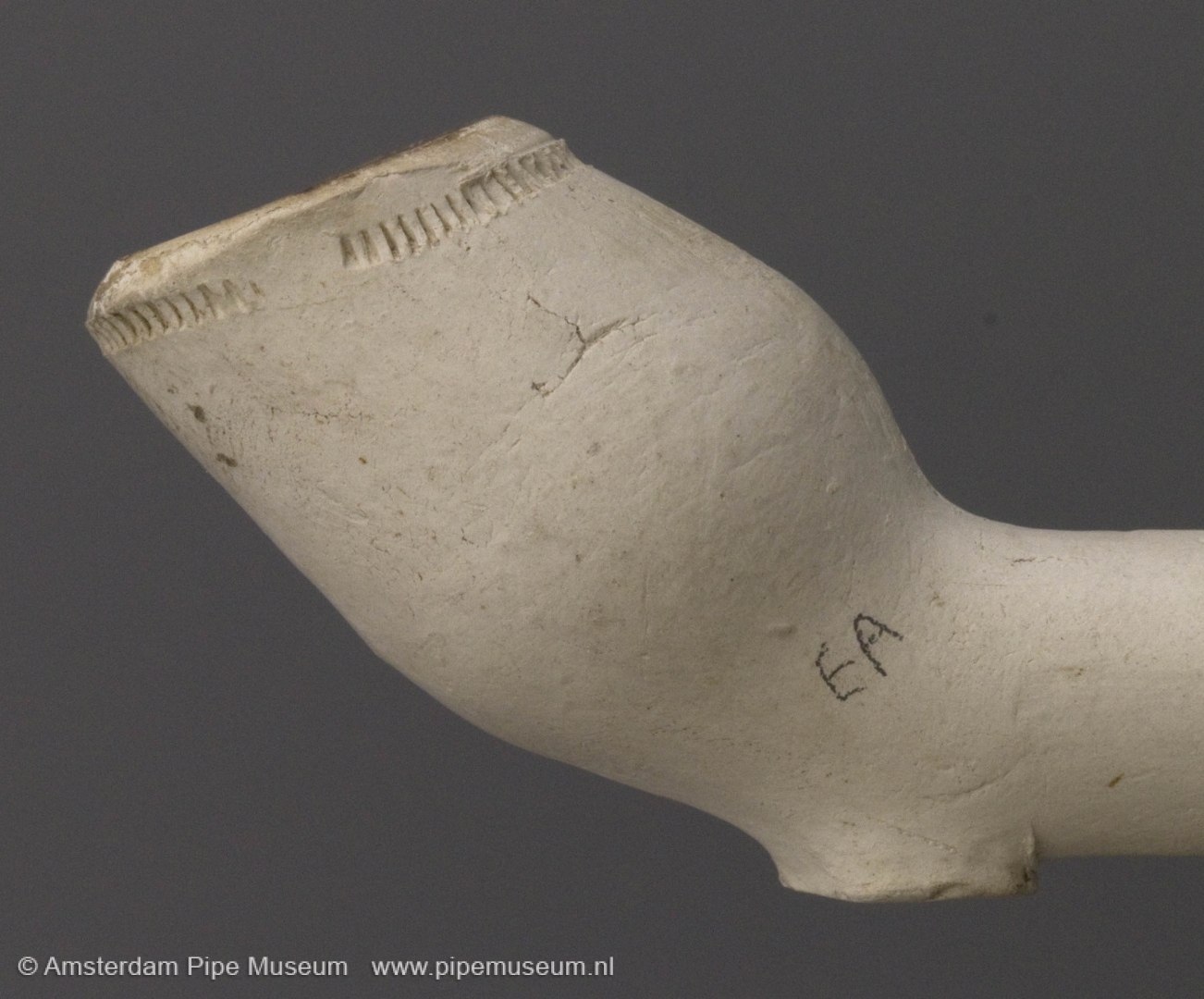


A positive factor, on the other hand, is that we know the range of products by Dutch pipe makers fairly well. The material itself is so current as an archaeological find, that we know what has existed, even though regional variations sometimes occur unexpectedly. For years determining the factor common pipe material has been the starting point for research into clay pipes and that picture has now been well-defined. Charged with that knowledge, we can use the information derived from each individual object to consider and elucidate the context information.
When creating a geographical classification, it is logical to take the product from Gouda as a starting point for trade relations. In the city of Gouda, the pipe-making industry turned into a main industry with clear features that show a large degree of standardization in each period. When comparing the largest common denominator of the Gouda product with other areas, we will notice the regional differences. For example, the pipe bowls from, for example, Gorinchem have slightly different shape characteristics, while in Amsterdam the so-called semi-fine pipe is becoming popular (Fig. 12). Other examples of regional patterns are the pipes from Leiden with a strongly bellied shape or those from Hoorn and Enkhuizen characterized by a typical bi-conical pipe bowl.
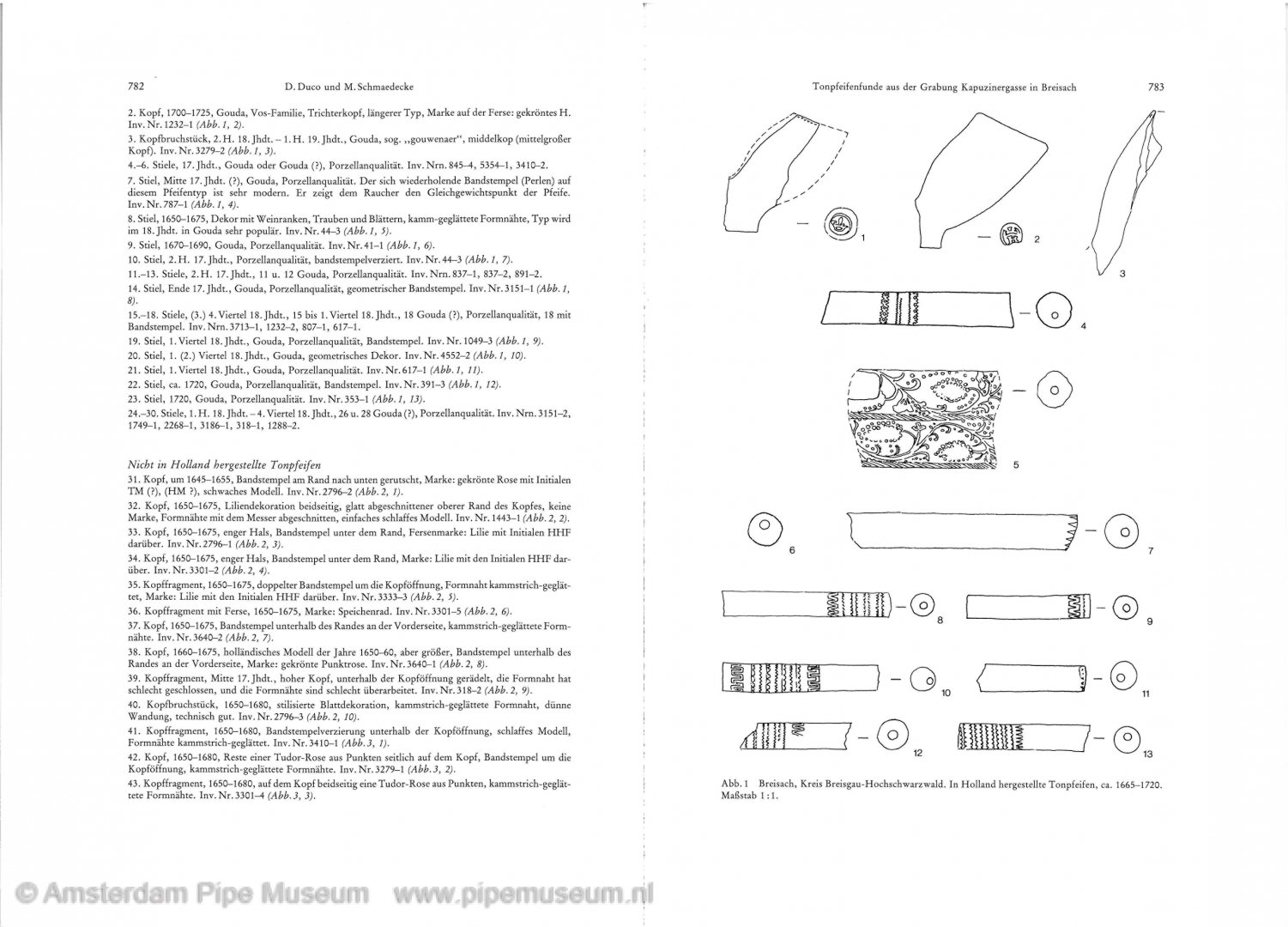
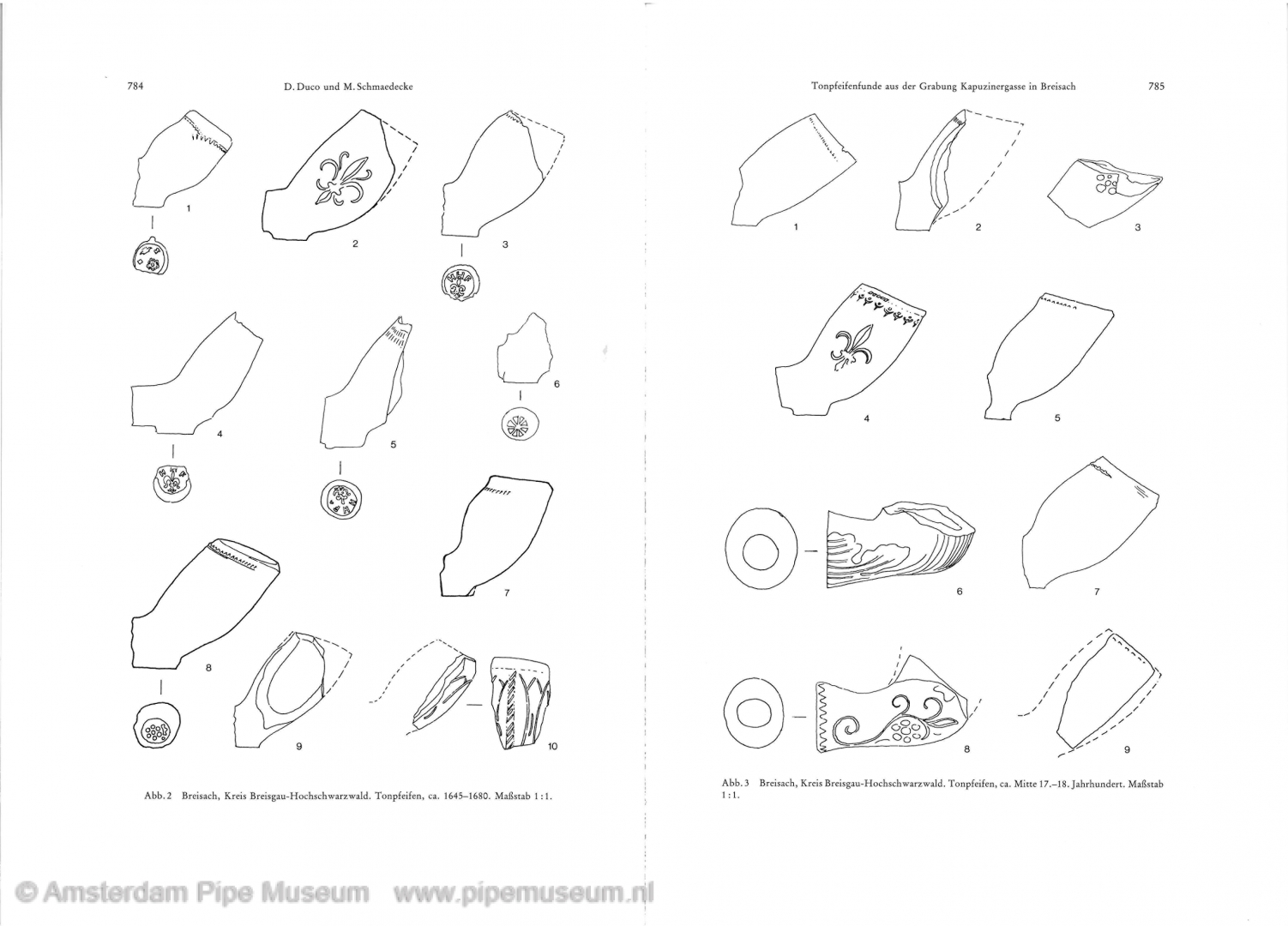
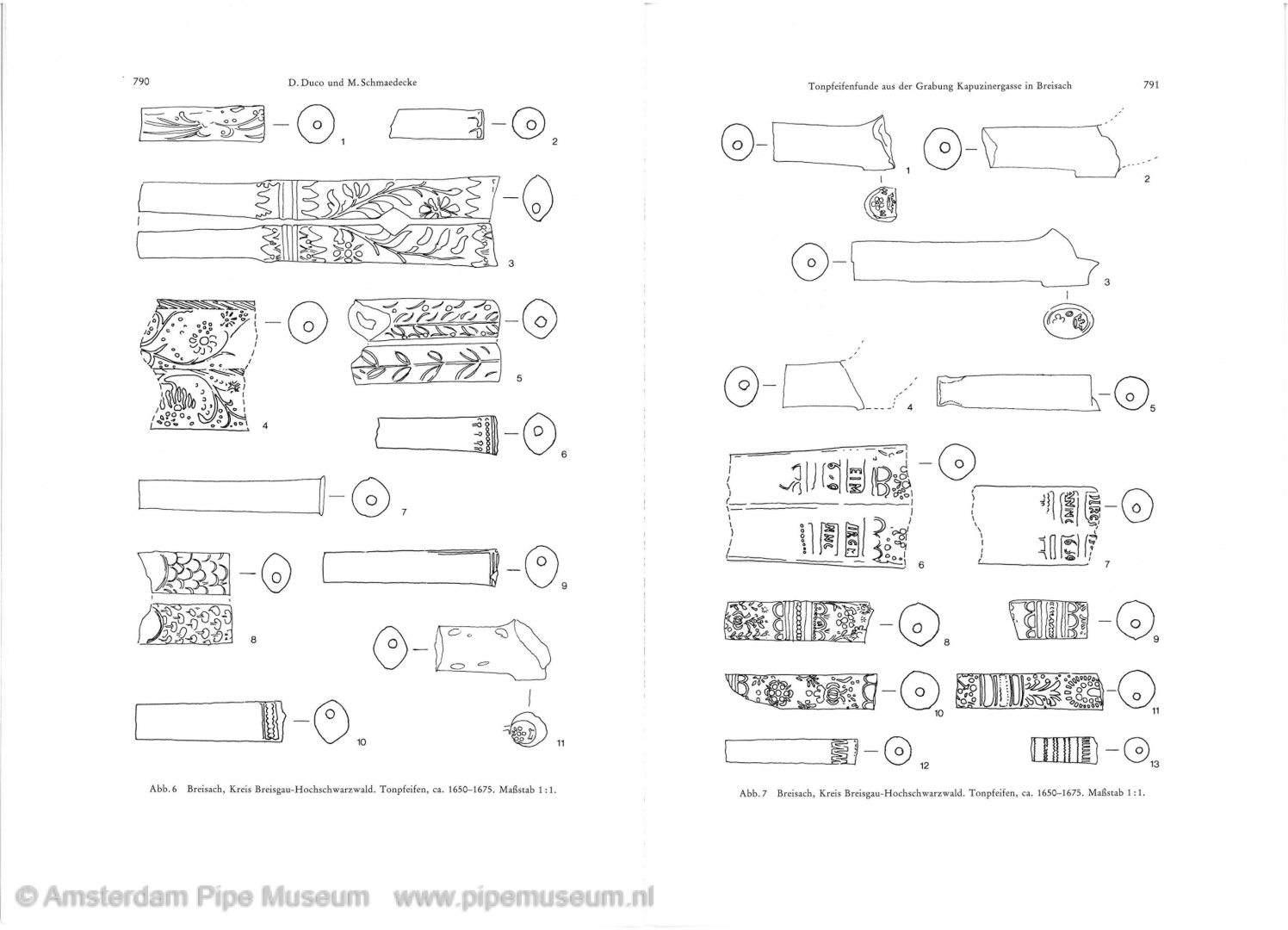
I have already set out the geographical relationship between the clay pipe shape and the production site in a publication (Fig. 13, note 8). A division has been made in five categories, namely the original Gouda product, the centres that imitate directly, centres that devise their own characteristics and centres that make something entirely unique. Finally there is another group, namely the centres where on request the style of another area is produced. In many production centres exploratory research has already been done, so the largest common denominator of the companies has been mapped. We observe that the Gouda characteristics fade away by increased distance from Gouda to be replaced by regional characteristics.
Differences between city and countryside are constantly changing over time, that was already known. Of course there is a close relationship between prosperity, fashion and status in relation to the trade at that moment. The investigation into the pipe has learned that specific user communities have preference for a specific and common type of smoking equipment in a certain place for a certain period of time. The taste component and the economic possibilities of the user change infinitely. A given is therefore that virtually no pattern can be projected on other areas.
An in-depth study of the clay pipe thus leads to fine-meshed patterns in production, trade and use that are significantly more accurate than is possible with household earthenware or decorative ceramics, for example. This is thanks to the reported standardized appearance of the clay pipe that has been in common use over four centuries in an ever-changing market supply. In addition, the circulation speed of the clay pipe is relatively short compared to other utensils. The clay pipe can thus provide a clear image from the details known about this product. For example, the distribution pattern can be determined fairly accurately, more precisely than with any other material. Optimum use from a small time unit can result in the clay pipe yielding fine-meshed patterns.
It speaks for itself that the importance of macro analysis is large. It places a certain production or consumption pattern in a broader context. However, an unexpected problem still arises in summarizing the whole picture into the report. The knowledge level of the find processor is never the same, so overlapping patterns incorrectly interpreted will give unexpected and incorrect variants. In fact, only comparisons from the same, more experienced researcher provide a representative and historically consistent picture.
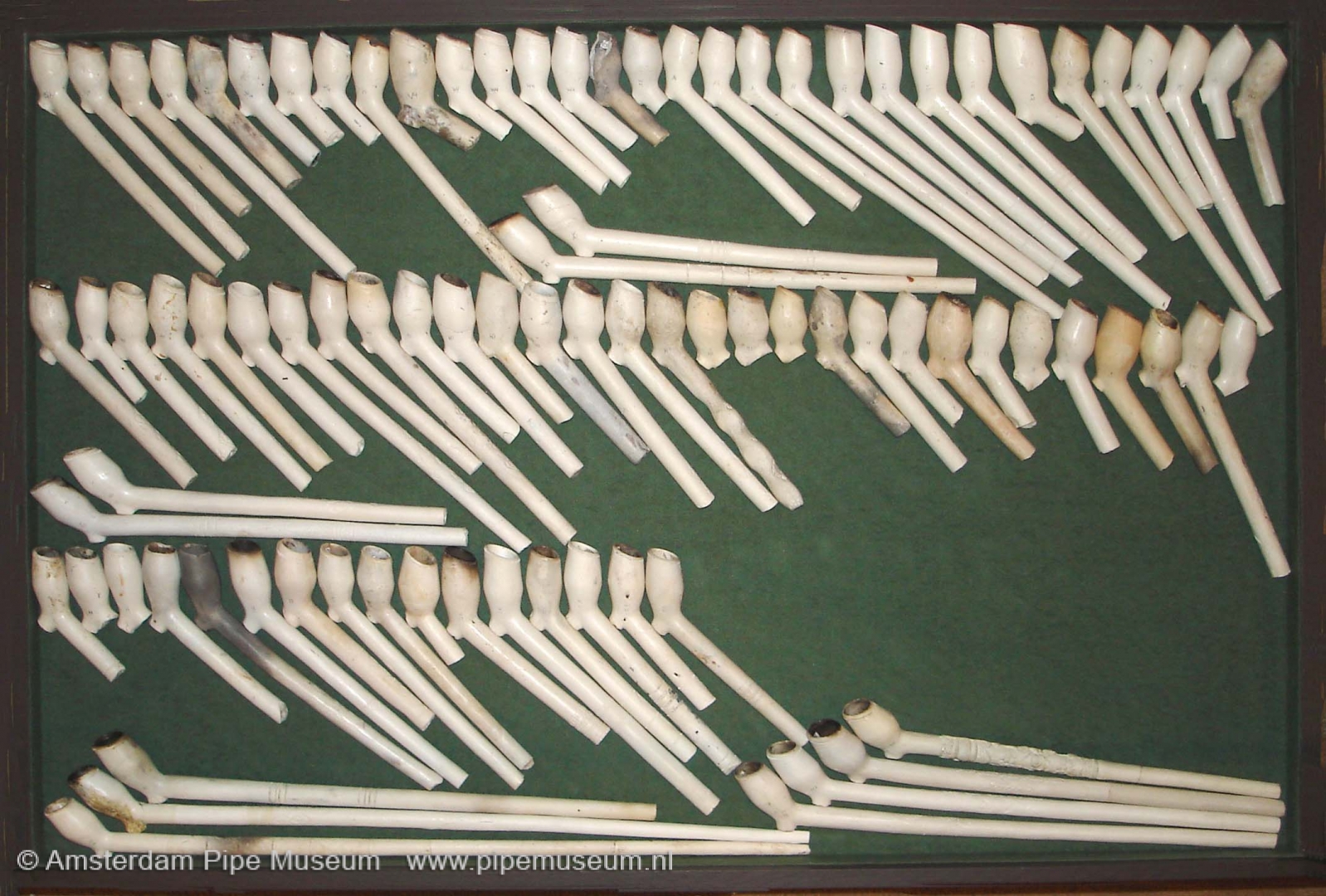
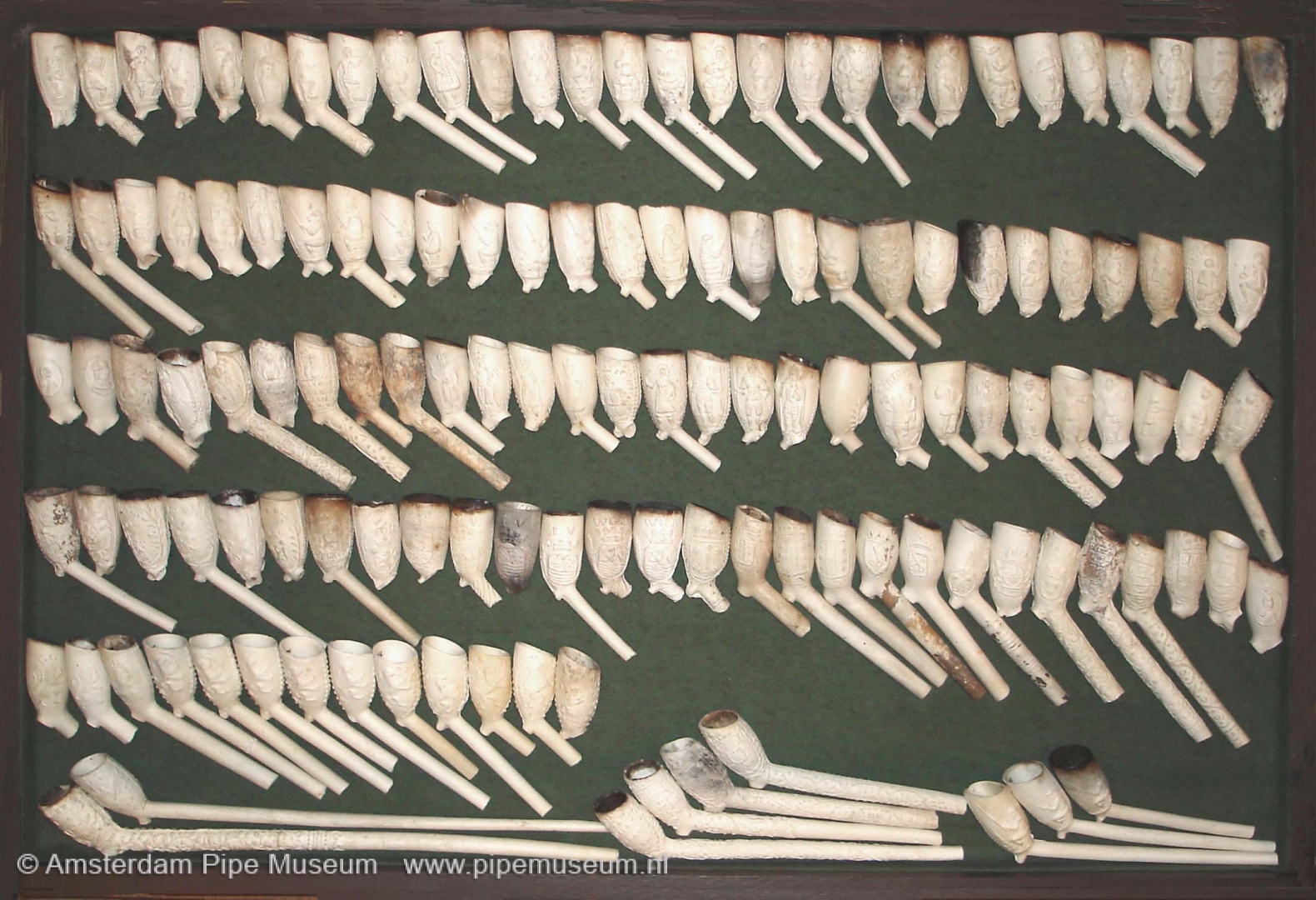

To map out the appearance of the clay pipe, the Pijpenkabinet Foundation has assembled a reference collection in which an example of each and every clay pipe has been brought together. This collection now comprises over 7,000 archaeological pipes that function as an encyclopaedia (Fig. 14). The objects are linked via a database to all conceivable other sources of information, such as archive data about people and brands, but also information from excavations. This unique collection acts as a national reference collection. Within a few years all this material will be consultable via the internet.
Finally, one can wonder how far we can get in knowledge gathering about the clay pipe. In view of the developments in the field of specialist natural science research, it can be expected that the future also has unsuspected prospects for smoking equipment, such as the clay analysis of the pipe, determination of the smoked tobacco and its origin, and so on. Traditional archaeological interpretation can therefore continue until we have mapped the production and are capable of determining the objects with sufficient evidence and can indicate the use and function within the social context. Then it is possible to interpret the historic smoking behaviour and the use of the clay pipe within the social context of the find location within the dimension of time and space. This means working towards an image in which the process of change can be stated with certainty at micro and macro level.
© Don Duco, Pijpenkabinet Foundation, Amsterdam – the Netherlands, 2003.
Illustrations
- Wast dump of a Gouda pipe maker. Gouda, Arend van Dijk, 1716-1732.
Amsterdam, Pijpenkabinet collections Pk 10.413a-n - Atypical tobacco pipe of a private smoker with bust of emperor Napoleon III. Rennes, Firm A. Crétal & E. Gallard, 1855-1860.
Amsterdam, Pijpenkabinet collections Pk 14.820 - Excavated pipe fragment with collection number in ink on the stem end.
Amsterdam, Pijpenkabinet collections Pk 2.878b - Fill-in list for pipe finds with pre-printed values.
Amsterdam, Pijpenkabinet documentation - Excel form on the computer.
Amsterdam, Pijpenkabinet documentation - Soot traces from smoking in the inside the pipe bowl. Gouda, Jan Nieuwveld, 1740-1760.
Amsterdam, Pijpenkabinet collections Pk 3.976d - Deductive determination method.
From: Duco, The Dutch clay pipes, handbook for dating and identification, 1987, pp. 141-146. - Clay pipe with filed mouthpiece as a sign of thriftiness. Netherlands, 1660-1685.
Amsterdam, Pijpenkabinet collections Pk 3.157 - The five basic shapes of the Dutch clay pipe.
From: Duco, The Dutch clay pipes, handbook for dating and identification, 1987, p 27, fig III. - Occasional purchase, pipe with curved stem and decoration of the Peace of Aachen. Gouda, Arij van Houten, 1784-1770.
Amsterdam, Pijpenkabinet collections Pk 197a - Tobacco pipe with shape meant for the Zeeland market, heel mark KP with stars. Middelburg?, 1650-1675.
Amsterdam, Pijpenkabinet collections Pk 15.028 - Semi-fine or typical Amsterdam pipe with heel mark and center of gravity stamp but without polishing. Amsterdam, 1630-1645.
Amsterdam, Pijpenkabinet collections Pk 215b - Drawings of pipe finds from the Schmaedecke publication.
Amsterdam, Pijpenkabinet documentation - Pijpenkabinet with drawer cabinets housing the reference collection excavated pipes.
Amsterdam, Pijpenkabinet photo archive
Notes
- Don Duco, ‘The Assortment of Arend van Dijk, pipe maker in Gouda, Holland’, Bristol/Leiden, 1988. Don Duco, ‘Een stortvondst van Dirk Barunet uit Gorinchem’, Leiden, 1990. Don Duco, ‘De pijpenstort van Jan Blij, een verkeken kans’, Leiden, 1992.
- D.H. Duco, ‘Kleipijpen’, chapter in: Schans op de grens, Sellingen, 1993, pp. 125-166.
- To be released: ‘Drie eeuwen tabakspijpen uit Alkmaar, een analyse van de kleipijpen na vijftien jaar stadskernonderzoek’ (Three centuries of tobacco pipes in Alkmaar, an analyses of the clay tobacco pipes after fifteen years of archaeological research).
- D.H. Duco, De Nederlandse kleipijp, handboek voor dateren en determineren, Leiden, 1987.
- In order to avoid double counting all bowl bases (including heel) are counted, other bowl fragments are left out.
- Arnold Carmiggelt, ‘MAE, wat doen we ermee?’, Assembled Articles, 1, Nijmegen, 1993, pp. 55-86.
- Duco, (‘Pijpenstort Jan Blij’), 1992.
- Don Duco, ‘The dating of pipes across Europe, A preliminary guideline’, in: Tonpfeifen in der Schweiz, Liestal (Schweiz), 1999, pp. 9-18.
Postscript
Het Verdrag van Malta, ook wel genoemd de Conventie van Malta of Verdrag van Valetta, is door de Raad van Europa ondertekend in 1992.
In Nederland zijn in 2003 alle principes uit het verdrag als wetsvoorstel ingediend. Het duurde echter tot 2007 voordat de Monumentenwet echt werd aangepast. Nu ook de archeologie hierin was opgenomen heet de wet sindsdien Erfgoedwet.
Een belangrijk aspect van de wet is het principe van 'de verstoorder betaalt', waar het dan gaat om het archeologisch onderzoek plus publicatie daarvan. De verstoorder kan het rijk zijn die wegen aanlegt, maar ook bouwberijven of particulieren die huizen bouwen of uitbreiden en daarvoor de grond verstoren. Gevolg hiervan was dat het budget voor onderzoek en publicatie enorm toenam, waardoor de opdrachten aan archeologische bedrijven en onderzoeksbureaus toenam.